Exonumia
Exonumia are numismatic items (such as tokens, medals, or scrip) other than coins and paper money. This includes "Good For" tokens, badges, counterstamped coins, elongated coins, encased coins, souvenir medallions, tags, wooden nickels and other similar items. It is an aspect of numismatics and many coin collectors are also exonumists.
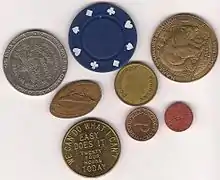
| Part of a series on |
| Numismatics the study of currency |
|---|
 |
Besides the above strict definition, others extend it to include non-coins which may or may not be legal tenders such as cheques, credit cards and similar paper. These can also be considered notaphily or scripophily.
Etymology
The noun exonumia is derived from two classical roots: exo, meaning "out-of" in Greek, and nummus, meaning "coin" in Latin (from Greek νοῦμμος – noummos, "coin"); thus, "out[side]-of-[the category]coins". The equivalent British term, paranumismatica, may also be used.
The words exonumist and exonumia were coined in July 1960 by Russell Rulau, a recognized authority and author on the subject, and accepted by Webster's dictionary in 1965.
Token Coins
Many tokens were produced and used as currency in the United States and elsewhere when there was a shortage of government-issued money. Tokens have been used for both to advertise and to facilitate commerce and may or may not have a value.
Token authority Russell Rulau offers a broad definition for exonumia in his 1040 page tome, UNITED STATES TOKENS: 1700–1900 [1] but lines between categories can be fuzzy. For example, an advertising token may also be considered a medal. Good For tokens may also advertise. Counter-stamped coins have been called "little billboards."
One way of parsing tokens is into these three general categories:
- Has a "value," facilitating commerce, such as Good for (something).
- Commemoration, remembrance, dedication, or the like, for some person, place, idea or event.
- Of a personal nature.
Typically, catalogs of tokens are organized by location, time period, and/or type of item. Historically, the need for tokens grew out of the need for currency. In America, some tokens legally circulated alongside or instead of currency. Hard Times Tokens and Civil War Tokens each were the size of the contemporary cent. Afterwards, value based items, such as Good for (amount of money), Good for One Quart of Milk, Good for One Beer, Good for One Ride… and others were specifically linked to commerce of the store or place of issue.
Medals
Medals are coin-like artistic objects, typically with a commemorative purpose. They may be awarded for recognition of achievement or created for sale to commemorate individuals or events. They may be souvenirs, devotional, or purely artistic. Medals are generally not used as currency or for exchange.
Exonumia Collecting
Exonumia collectors, like coin collectors, are attentive to condition and rarity, as well as to history, form and type. Exonumists may collect items by region, topic, type, shape or material and this affects the ways tokens are documented.
The following categories are typical. This is not all-inclusive but is a sampling of the wide variety of exonumia.
By type
Modified/Augmented:
- Love Token: A coin with hand engraving, generally on one side, or deliberately bent.
- Carved Potty coins: usually United States Seated Liberty coinage carved to show lady Liberty sitting on a chamber pot.
- Hobo nickels: Initially, hand-engraved Buffalo nickels mostly in the era 1913–38. Now, applied more generally to hand-engraved coins of different denominations.
- Counterstamped/countermarked or chopped coins (done by merchants or governments)
- Cut Coins: artistically carved creations made from genuine coins, both new and old, often for jewelry.
- Elongated coins: Rolled out with advertising, commemorative, or souvenir designs on one side
- Encased Coin: Generally in a ring with advertising
- Colored or painted circulation or bullion issues
- Short snorter: paper money signed by people sharing a common experience
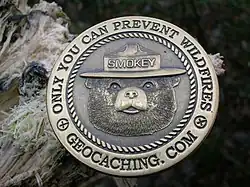
Play money / Fantasy / Counterfeit / Art
- Play money
- Fantasy issue or novelty money (e.g. Promotional fake United States currency, Prop money)
- Mardi Gras Doubloons
- Counterfeit coins
- Money art
Government Services & Non-National tools to Facilitate Commerce
- Jetons: Used as counters when verifying totals or weights of coins for commerce and exchange
- Telephone tokens/Gettoni
- Evasion tokens: 18th century semi-counterfeit were made to look like kind of but not exactly like actual currency[2]
- Local currency, e.g. Ithaca Hours
- Sales tax tokens: Issued by states and merchants
- Dog license tags
- Post office tags
- Food stamps
- Slave tags: see Slave codes
Transportation Tokens
- Ferries and watercraft
- Buses
- Subway
- Trains
- Trams/Trolleys
Closed Community / Membership
- Communion tokens: given to congregation members to permit them to participate in Holy Communion)
- Company scrip
- Ingle Credit System script
- Lumber
- Mining
- Civilian Conservation Corps (CCC)
- College Currency
- Challenge coins
- Fraternal
- Geocoins used in geocaching
- Leper colony money
- Military Store and Entertainment
- Plantation
- Picker tokens for crops
- Prison and Correctional/Asylums
- Sobriety coin
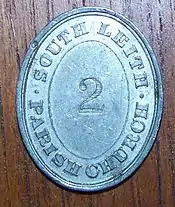
By material / shapes
- Wooden nickels
- Cardboard or paper
- Hard rubber or ebonite
- Bullion, e.g. non-legal tender silver rounds
Movements and ideals
- Temperance
- Anti-slavery
- Religious (including temple tokens)
- Political tokens, e.g. Bryan Money
Of a Personal nature – Personals
- Key tags (e.g. In case lost return to …)
- Badges
- Company
- Occupation
- Hand-engraved or uniquely counterstamped coins, as pocket pieces
- Watch fobs
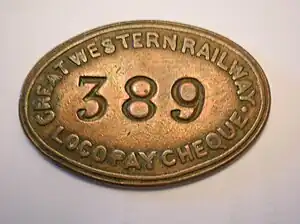
By Issuer
- Arcade/Amusement tokens
- Apothecary tokens
- Bakery token
- Beer
- Pub/bar/saloon
- Billiards/pool
- Brothel tokens
- Car wash tokens
- Casino/Slot tokens/Casino chips
- Cigar/smoke shops
- Coat check
- Disney Dollars
- Fisherman tokens
- Milk/dairy
- Parking tokens: for meters or gates
- Pay toilet tokens
- Peep show
- Railway cheque tokens
Medals
- Politicians, inventors and other notables, e.g. George Washington
- World's fairs or other expositions
- City or state anniversaries
- So-called dollars: medals and souvenirs similar in size to a silver dollar commemorating American historical events such as world's fairs, anniversary celebrations, dedications, battles, public works projects, etc.[3]
Modern items under the exonumia umbrella include:
- Credit cards
- Gift cards: Gift cards have been replacing the giving of cash for events
- Telephone cards
- Music cards
China
There are many types of Chinese exonumia, including alternative currencies:
and numismatic charms:
Germany
Notgeld, primarily in the form of paper banknotes, was issued in Germany and Austria during World War I and the interwar period by towns, banks and other institutions due to a shortage of money.
Latin America
Latin American coffee or plantation tokens were an important part of commerce.[4] Many plantation owners had their own commissaries and workers used plantation tokens to pay for provisions. Many tokens were made in the United States or Europe. Plantation tokens had an array of denominations and names. The name can be the owner, their relatives or the name of the farm (or finca). Tokens had allegorical symbols to identify the owner. Tokens were used as currency when there was not enough official currency available. Workers could convert the tokens to official currency on Saturdays.
Tokens were made in all types of base metals and alloys plus plastic, celluloid and bakelite. Unique to Costa Rica were tokens made of paper (paper chits). The word "boleto" is used in Costa Rica for the word token whereas "ficha" is used in the rest of Latin America.
United Kingdom
Conder tokens were privately minted tokens from the later part of the 18th century and the early part of the 19th century in England, Anglesey and Wales, Scotland, and Ireland.
United States
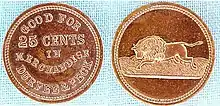
Rulau [1] breaks down American tokens into these general time periods:
- Early American
- Hard times tokens were made during the "hard times" after President Andrew Jackson shut down the Second Bank of the United States. These tokens were issued privately to circulate in the local economy as a one cent coin. They had a wide variety of subject matter, including advertising and political/satirical themes (anti-slavery, anti-Jackson).
- Civil War tokens were made between 1861 and 1864 due to the scarcity of government-issued cents during the American Civil War. Encased postage stamps were also used for this purpose.
- Merchant (including modern gas tokens, ex: Shell tokens)
- Trade tokens
- Gay 90s
References
- Rulau, Russell. Standard Catalog United States Tokens 1700-1900.
- McKivor, Bill. "18th Century "EVASION" TOKENS". The Copper Corner. Retrieved 2017-01-30.
The laws were written to cover Regal coinage. If a coin was made that was not an EXACT COPY of the Regal coin, it was considered to be a token, and the law did not apply. Thus, the counterfeiters simply switched from making counterfeit coins to making "Evasion" token coinage that looked somewhat like the regal coin.
- "Quick Introduction to So-Called Dollars". So-called Dollars. Retrieved 9 September 2023.
- Rulau, Russell. Latin American Tokens: An Illustrated, Priced Catalog of the Unofficial Coinage of Latin America—Used in Plantation, Mine, Mill, and Dock—From 1700 to the 20th Century.
Further reading
- Collecting U.S. Tokens: Challenges and Rewards, R. Leonard, Chicago Coin Club
- Trade Token Tales, an educational website on trade tokens
- PlantageGeld, Plantation tokens, mainly Netherlands East Indies, British North Borneo and Ceylon (in Dutch)
External links
- Token And Medal Society
- Civil War Token Society
- Richard's Token Database Searchable database for Good For's and other items

.jpg.webp)